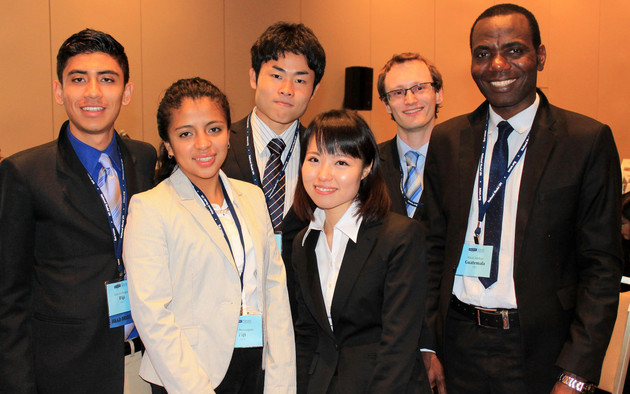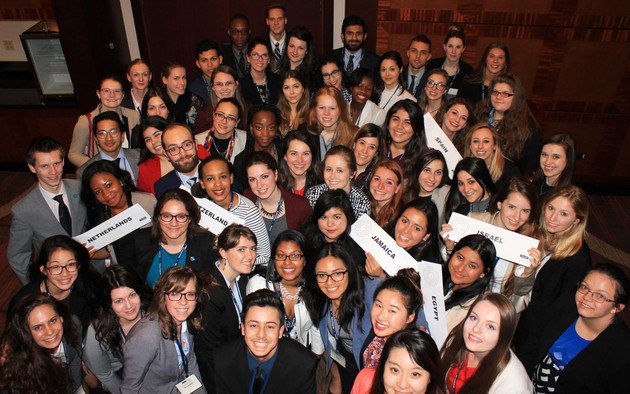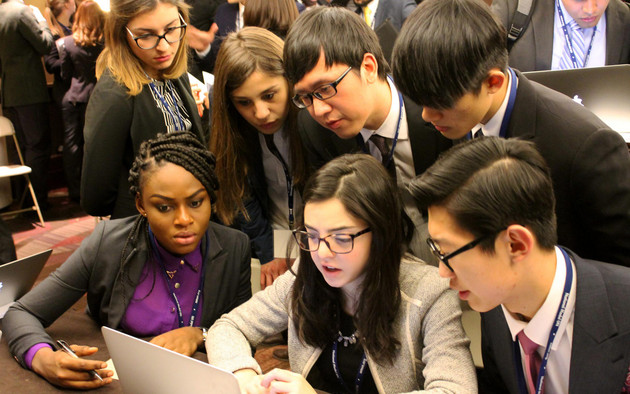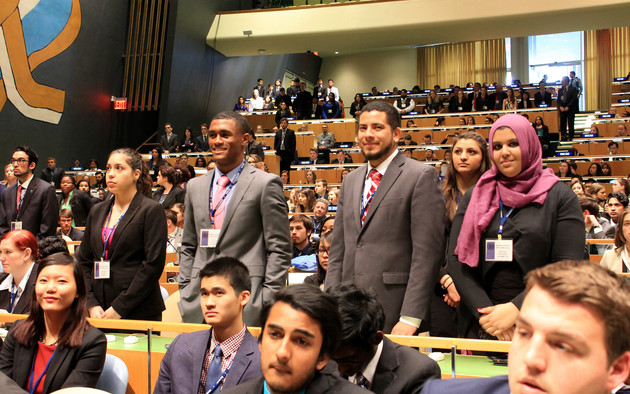
About Us
National Model United Nations (NMUN) is the world's largest, most prestigious, most diverse, and oldest ongoing university-level Model UN.

Our Mission
To advance understanding of the UN and contemporary global issues through quality educational programs that emphasize collaboration and cooperative conflict resolution and prepare participants for active global citizenship. We envision a world comprised of civically engaged people who strive for peaceful, multilateral conflict resolution and equitable, sustainable human development.
We are a U.S. 501(c)(3) nonprofit organization.

Guiding Principle
Cooperative, hands-on, experiential learning allows students to confront a range of topics with the perspective of their assigned country or organization. Through these experiences - during preparation, committee sessions, and hallway caucuses - students develop an appreciation of differing viewpoints, experience the challenges of negotiation, see the rewards of cooperation, broaden their world view, and discover the human side of international relations and diplomacy.

Learning Outcomes
Model United Nations allows delegates to apply theoretical knowledge of international relations and of the United Nations system in a practical, hands-on setting. Through preparation and participation in NMUN, students will develop transferable skills such as leadership, negotiation, collaboration, public speaking, researching, and technical writing; advance a responsibility to be actively involved in global issues; and enhance their understanding of the structure of the international system and challenges of global diplomacy.

UN Involvement
NMUN has been a recognized Non-Governmental Organization (NGO) formally associated with the United Nations Department of Global Communications since 1982.
Numerous conference speakers work for the UN. It has been our privilege to have UN Secretaries-General Ban Ki-moon, Kofi Annan, Boutros Boutros-Ghali, and Kurt Waldheim; and Deputy Secretaries-General Amina J. Mohammed and Jan Eliasson serve as keynote speakers. UN officials have also served as advisory group members, and many student delegations meet with their official national delegations during the conference. In addition, the UN Human Resources Office has presented Career Opportunities at the UN Secretariat to our attendees.
In the past, UN Headquarters facilities, including the General Assembly Hall, have been requested and granted when available and approved, for holding opening / closing sessions at our New York conferences. In 1952, NMUN was the first Model UN conference to use the UN Headquarters in New York City for our final session.
NMUN was a pioneer in using rules more aligned with those used by the UN. The rules of procedure used at our programs were adapted by us from actual UN rules. The UN Institute for Training and Research (UNITAR) reviewed and approved them in the 1990s.
A Brief History
Our roots go back to the intercollegiate Model League simulation in 1927 at Syracuse University. Subsequent conferences, known as the Model Assembly of the League of Nations, Middle Atlantic Section, were hosted at various Mid-Atlantic college and university campuses. The transition to a Model UN simulation began in 1943 at Hamilton College campus and 1944 at Bryn Mawr College campus where model United Nations (World War II allies) simulations were held instead of a Model League of Nations. Annual conferences in our lineage have been held every year since 1927 with the exceptions of 1945 when U.S. World War II travel restrictions prevented a meeting and 2020 when our NMUN•New York conferences had to be canceled due to COVID-19 quarantines and travel restrictions.
The March 1946 conference was the first one held under our new name: the Middle Atlantic Model (UN) General Assembly (MGA); this was the first Model United Nations conference held after the ratification of the UN Charter. Lafayette College was the host institution. In 1964 the name was changed to National Model (UN) General Assembly (NMGA). From this year on, the conference was held in New York City rather than on campuses.
For the most part, from 1927-1967, the conferences were organized by a Continuation Committee in conjunction with a Mid-Atlantic college or university and the League of Nations Association (LNA), then its successor the American Association for the United Nations (AAUN) or their college affiliate the Collegiate Council for the United Nations (CCUN).
After the 1967 conference, the official name became NMUN. In 1968, to ensure the long-term success of the conference, the organizers incorporated under the name National Collegiate Conference Association (NCCA). In 1974, the board developed the National High School Model UN (NHSMUN) conference. The first NHSMUN conference was held 15-18 May 1975 in New York City. On 7 October 1978, NHSMUN was transferred to a separate nonprofit organization, the International Model United Nations Association (IMUNA). Since 2007, we have held annual NMUN conferences in Washington, DC. In 2008, we started running NMUN conferences outside of the U.S. with partners from around the globe. In 2017, it was decided to retire the NCCA name and use NMUN for both the intercollegiate conference and governing board. Our conferences continue to provide quality educational programs that bring together the next generation of international leaders. Our annual NMUN•New York conferences are the largest and most established premier intercollegiate Model UN conferences in the world serving a diverse group of students from around the globe.
Read our NMUN History, NMUN Historical Timeline, and the NMUN Milestones below for more information.
Milestones
|
1927 |
The first conference begins as a Model Assembly of the League of Nations at Syracuse University. It is composed of students and faculty from New York colleges and universities. It is believed to be the first United States intercollegiate simulation to meet under that name. “As far as can be ascertained, this is the first time that a Model Assembly of the League of Nations, participated in by a number of universities, has been held in the United States.” (A Model Assembly of the League of Nations, Bulletin of Syracuse University, Vol. 27, No. 17c, [1927?], p. 7) |
|
1928 |
The conference expands in its second year and welcomes students from colleges and universities in Mid-Atlantic states. It becomes the Model Assembly of the League of Nations, Middle Atlantic Section. |
|
1933 |
The first constitution and by-laws are adopted. They include the creation of a Continuation Committee composed of 4 faculty, 4 students, and a representative of the League of Nations Association. |
|
1942 |
The term United Nations is used in the document entitled Declaration by United Nations. |
|
1943 |
The conference attendees represent United Nations countries (WW II allies). The United Nations and the Organization of Peace is the main topic. This is the start of the transition to a Model UN simulation. President Cowley of Hamilton welcomed the delegates yesterday as “the first group of people ever to get together under the aegis of that phrase, United Nations.” (New York Times, March 20, 1943, p. 12.) |
|
1944 |
Once again the delegates represent United Nations countries (WW II allies). Possible solutions to the issues faced by the United Nations related to establishing an international organization is the theme. |
|
1945 |
Due to the U.S. Office of Defense Transportation's travel restrictions related to World War II, this is the first time this conference is not held. |
|
1946 |
The conference becomes the Middle/Mid-Atlantic Model (UN) General Assembly (MGA). It's the first Model United Nations simulation to be held after the ratification of the UN Charter. |
|
1950 |
The final session for this conference is held at UN Headquarters in Lake Success, New York. |
|
1952 |
The final session for this 25th conference is held at the new UN Headquarters building in New York City. The first conference to use the building for this purpose. Once the conference is permanently held in NYC, holding opening/closing sessions at the UN when the space is available, becomes a permanent tradition. “Oscar A. DeLima, Executive Vice-President of the American Association for the United Nations, noted that the Middle Atlantic Model United Nations is the parent of all other Model Assemblies.” (Model United Nations General Assembly 25th Session - 1952 25th Anniversary Conference Program, p. 7.) |
|
1956 |
Eleanor Roosevelt serves as the keynote speaker at the final session. |
|
1960s |
The conferences are staffed by Harvard, Yale, Georgetown, and other U.S. east coast students. In this decade the conference transitions from being held on different campuses to being held at a hotel in New York City. |
|
1961 |
Eleanor Roosevelt serves as the keynote speaker at the opening session at the UN building in New York. |
|
1964 |
The conference becomes National Model (UN) General Assembly (NMGA). |
|
1967 |
After the 1967 conference, the official name of the conference becomes National Model United Nations (NMUN). |
|
1968 |
The governing body incorporates as National Collegiate Conference Association (NCCA) on 30 April to assure the long-term educational integrity and financial success of the NMUN conference. |
|
1973 |
UN Secretary-General Kurt Waldheim serves as a keynote speaker at the annual NMUN conference in New York City. |
|
1974 |
NCCA develops the National High School Model UN (NHSMUN) conference. The first conference is held 15-18 May 1975. On 7 October 1978, NHSMUN incorporates a separate nonprofit organization, International Model United Nations Association (IMUNA), that operates NHSMUN independently from the NCCA. |
|
1981 |
NCCA creates a New York Advisory Group. |
|
1982 |
NCCA/NMUN is named a non-governmental organization (NGO) with consultative status to the U.N. Department of Public Information (name changed to U.N. Department of Global Communications in 2019). |
|
1990 |
NCCA develops the Southern Regional Model UN conference (SRMUN) in Atlanta in response to the absence of Model UN opportunities in the region. In 1993 SRMUN incorporates as a separate nonprofit organization. |
|
1990s |
The rules of procedure used at NMUN programs which we adapted from actual UN rules are reviewed and approved by the UN Institute for Training and Research (UNITAR). |
|
1999 |
UN Secretary-General Kofi Annan serves as a keynote speaker at the annual NMUN conference in New York City. |
|
2004 |
In order to manage the growth of the conference and provide more professional service, the first full-time, paid employee is hired, an Executive Director. |
|
2007 |
To better serve participants, NMUN is held as one conference at two New York City venues. More than 4,000 students attend, half from outside the United States. The first NMUN•DC conference is held. |
|
2008 |
UN Secretary-General Ban Ki-moon serves as keynote speaker at the annual NMUN conference in New York. |
|
2013 |
NCCA/NMUN becomes a registered UN Academic Impact member. |
|
2014 |
NCCA creates a DC Advisory Group. |
|
2015 |
UN Secretary-General Ban Ki-moon once again serves as a keynote speaker at the annual NMUN conference in New York City. |
|
2017 |
A decision is made to retire the NCCA name and operate both the conferences and the governing body under the NMUN name. |
|
2020 |
COVID-19 concerns cause New York City to cancel gatherings of more than 500 people, this is only the second time in our history that this annual conference is not held. Due to the continued spread of the coronavirus, our DC conference transitions to an online event. |
|
2021 |
Due to travel bans and quarantines caused by the global pandemic, for the first time the New York conference is held virtually. |
|
2023 |
The NMUN Advisory Groups for DC and New York are combined. |